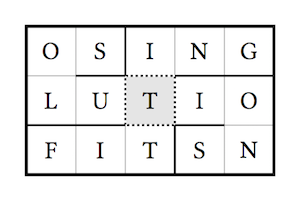In this puzzle, you'll have to rebuild words using the "pieces" listed at the bottom and place them in the grid provided below. Some notes about this puzzle:
- The gray cells with the dotted border are cells in common. Therefore each one of such cells shares two words. The gray cells at the center, which appear without any particular border, are used by one word each (so, not shared, but still important for the solution, of course).
- Words can go in any direction (i.e. not just $\rightarrow$ right, or $\downarrow$ down).
- Words must follow the thicker borders when placed in the grid. The thinner grid is only there to show you where each letter goes.
When encountering a gray cell, the only permitted direction is forward. So if there is a crossing, go straight, if there is a "wall", either stop there, or start from there. See these two examples:


Note: These two are only examples of directions, they may not necessarily show the writing direction.
Here's an example showing two words (FITTING, SOLUTIONS) that cross each other.

When the grid is properly filled, the gray cells (including the ones at the center) will give the name of a famous artist. The name is ciphered, however it will be possible to properly decipher this name with the information provided.
The words in the grid can be theoretically split into some categories:
- Words related to the name of the artist.
- Words that seem to be related but are there to confuse you.
Words that are unrelated to the topic of the solution.
However, don't worry: the number of words in these categories is in descending order (so most of the words will be related to the proper solution, while very few will be unrelated). This means that the more you solve, the clearer the puzzle is going to be.
- Words may belong to any word category (proper noun, verbs, etc.).
- The letters in the grid are cryptic clues, they do not indicate what letters go in those cells.
- All the fragments below are used exactly once and none of them is to be considered an independent word. For example "tomb", while existing on its own in English, is to be considered a fragment in this question. The fragments have been created by using the Merriam-Webster dictionary to hyphenate the words. In case the word was not available, I chose the most common hyphenation (other services, etc). Also, in case of plurals, the -s is not separated, rather it appears along with the last syllable. Therefore "solutions" would appear as so-lu-tions.
- Attention to detail will be key in solving this puzzle.

The broken pieces:
a a al als an ard ary ba ba bac bal bap bi brism chus cus da dom du e e e en er er ere ex ex ge gen gin hearse i ian ile ing ital jon lad law laz laz lit liz mar mas me ment nas oc og phy pi quar quez qui quil ra rais re re rence ri ro roque rus ry sa sa sculp sex sis tam ten ter thes tiks tist tomb tor ty tyr u ve vi vir viv
The aim, as stated, is to solve the puzzle, however answers that will explain the relation (or lack thereof) of the words in the grid to the final solution will be taken in better consideration.
Note: I did add the no-computers tag, however I'd like to clarify that this refers only to automatic scripts and the like. Using a crossword solver et similia (which you then check manually) is completely fine.

